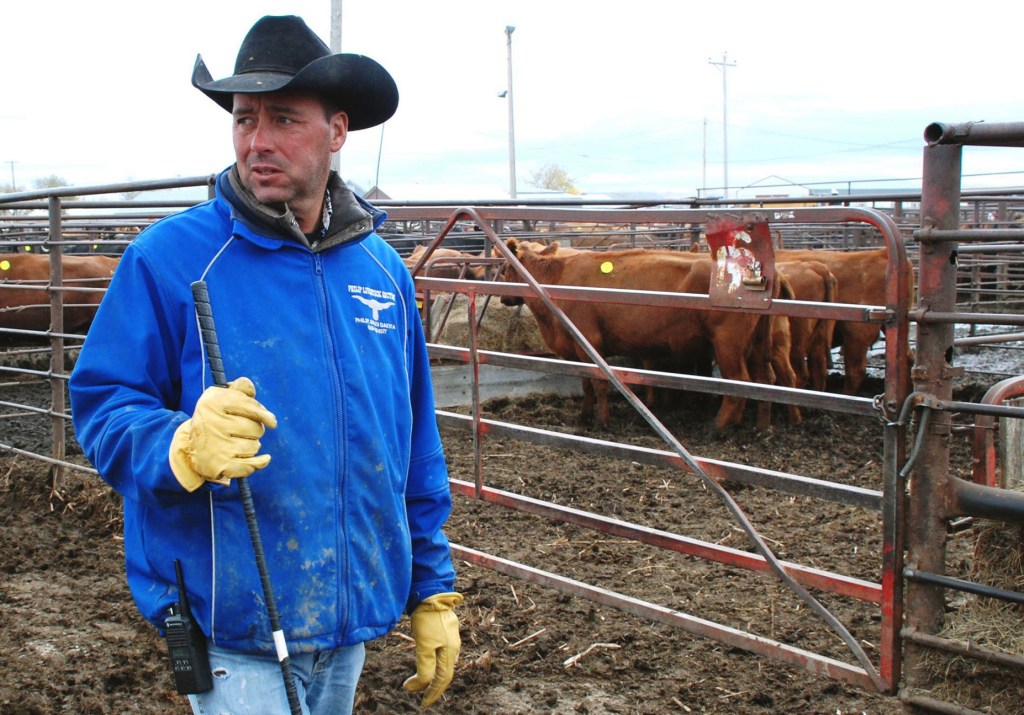PHILIP, S.D. — Joe Carley has nearly finished burying the cattle he lost in a freak early fall blizzard that killed tens of thousands of cattle in western South Dakota. Now, he’s figuring out how to dig himself out of the financial hole left after about a quarter of his cows and maybe a third of his calves died in the storm.
“There’s some sleepless nights. There’s a lot of worry. My brain’s always rolling. We’re pulling ourselves out of it, you know. We’re trying to figure things out and step forward,” Carley, 40, of Philip, said during a break from herding cattle at the local livestock sale barn, where he works to help make ends meet.
Other ranchers in the area also don’t plan to give up, despite what state officials have estimated as a loss of 15,000 to 30,000 cattle in the Oct. 4-5 storm that dumped up to 4 feet of snow in some parts. The financial loss is staggering, with each calf worth more than $1,000 and each pregnant cow worth $1,500 to $2,000. To make matters worse, most ranchers were only a few weeks away from selling the calves born last spring – their paycheck for the year.
Ranchers like Carley may get low-interest loans or loan guarantees from a U.S. Agriculture Department program and could get some help from a relief fund set up by livestock organizations that have so far collected donations of $400,000 from people in nearly every state and some other countries. A Montana organization is asking ranchers in that state to donate heifers that can be given to help South Dakota ranchers rebuild their herds.
Ranchers also could get a big boost if a federal livestock disaster program that expired in 2011 is revived in a new farm bill. The House and Senate versions of the new farm bill include provisions to do just that and to provide retroactive payments, but the two chambers have been unable to agree on a farm bill after passing different versions several months ago. Spurred partly by the disaster, the House and Senate now plan to restart negotiations.
“Anything will help, I guess,” said Carley, who lost 51 cows and 70 calves. “We’re not asking for handouts, either, but there are a lot of people in need around here.”
Dave Schriever, vice president of lending for First National Bank of Philip, said most ranchers will survive after selling their remaining calves at current high prices. Recovery plans will vary according to each rancher’s situation, debt load and size of loss, he said.
“Obviously, some people out there got hit really hard. They’re going to struggle for the next several years trying to get their operations to work, trying to get the cash flow to work,” Schriever said, talking over the staccato voice of an auctioneer during a visit to the Philip Livestock Auction on a sale day.
The snow has since melted in South Dakota’s ranching country and autumn-browned grass covers the hills as yellow leaves of cottonwood trees light up valleys. But less than a month ago, the area looked more like tundra. Some cattle and horses left corrals and barns, only to die in the blizzard. Many drifted with the wind before dying against fences or in draws they could easily have left. Others crossed fences, drifted as much as 20 miles from home and mixed with neighbors’ herds.
Chuck O’Connor, 76, of Philip, said 45 of his cows and 50 calves died out of a herd of about 600 cows and 600 calves. One bunch walked into a shallow draw, stayed there and died. Some cattle seemed to drift with the wind. Others walked into it. O’Connor said he lost more than $100,000 worth of cattle, but he had 560 calves left to sell.
“There’s just a lot of things about this storm I don’t understand. It was different,” said O’Connor, a board member of the South Dakota Stockgrowers Association.
Mark Buchholz, 51, of Philip, said he and his hired hand lost a total of 375 cattle. He plans to recover from the losses.
“I’ve been doing it for 30 years, so you go in and meet with your local banker. You hope like heck they can work you through it,” Buchholz said.
The storm killed some cattle in parts of Nebraska, Wyoming and North Dakota, but the losses were generally far smaller than in South Dakota. Ranchers in southwestern North Dakota suffered losses in the single or double digits and will still need some financial help to recover, said Julie Ellingson, executive vice president of the North Dakota Stockmen’s Association.
“Our community is pulling together. We live in one of the greatest places in the nation. Neighbors pull together,” Carley said. “I wasn’t left alone after the storm for probably four days. That was great. I needed the help.”
Send questions/comments to the editors.



Success. Please wait for the page to reload. If the page does not reload within 5 seconds, please refresh the page.
Enter your email and password to access comments.
Hi, to comment on stories you must . This profile is in addition to your subscription and website login.
Already have a commenting profile? .
Invalid username/password.
Please check your email to confirm and complete your registration.
Only subscribers are eligible to post comments. Please subscribe or login first for digital access. Here’s why.
Use the form below to reset your password. When you've submitted your account email, we will send an email with a reset code.